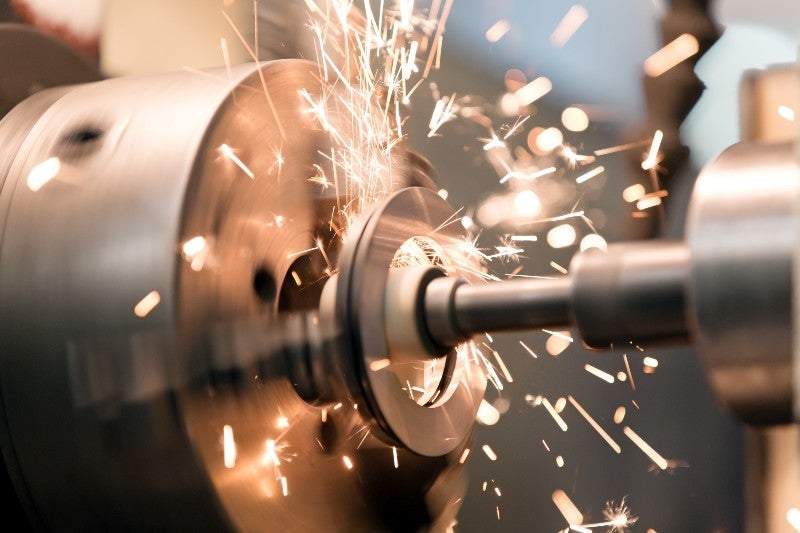Steel guidewire core wire grinding is a critical step in the production of medical devices such as catheters, guidewires, and stents. These thin wires, known as core wires, serve as essential conduits for delivering instruments and treatments within the body. Precision grinding enables the attainment of specific diameters, tapers, and profiles, ensuring the functionality and efficacy of the final product. Grinding is indispensable in achieving the required dimensions and surface finish crucial for the safe and effective use of these medical devices.
Grinding Process
The grinding process for steel guidewire core wire is a multi-step procedure designed to achieve precise dimensions and surface finishes. Here’s a breakdown:
Rough Grinding
- Initial Passes:
Introduction of the core wire to the grinding wheel.
Initial shaping to remove excess material.
- Coarse Grit Selection:
Selection of a grinding wheel with coarse grit.
Efficient material removal to expedite the process.
- Removal of Surface Imperfections:
Focus on eliminating any surface irregularities or defects.
Ensuring uniformity and smoothness for subsequent stages.
Fine Grinding
- Finer Grit Selection:
Transition to a grinding wheel with finer grit.
Refinement of the core wire’s surface texture.
- Smoothing out the Surface:
Continued grinding to achieve a smoother finish.
Attention to detail to eliminate any remaining imperfections.
- Achieving Precise Dimensions:
Emphasis on dimensional accuracy to meet specifications.
Control over the diameter, taper, and profile of the core wire.
Coolant Usage
- Importance of Coolant:
Application of coolant to regulate temperature and reduce friction.
Prevention of heat-induced damage to the core wire.
- Types of Coolants Suitable for Grinding Steel:
Selection of appropriate coolant types, such as water-based or oil-based.
Consideration of environmental and health factors in coolant choice.
Monitoring and Adjustments
- Regular Inspection of Grinding Wheel:
Periodic examination of the grinding wheel for wear and tear.
Replacement or dressing of the wheel as needed.
- Adjustments for Optimal Results:
Fine-tuning of grinding parameters for desired outcomes.
Optimization of feed rates, wheel speed, and pressure.
- Monitoring Temperature to Prevent Overheating:
Vigilance in monitoring temperature levels during grinding.
Implementation of measures to prevent overheating, such as adjusting coolant flow or reducing grinding pressure.
Through these stages, the grinding process ensures the core wire meets stringent quality standards and is ready for further processing or integration into medical devices.

Specification of Demax Steel Guidewire
Here’s a specification table for Demax Steel Guidewire:
| Specification | Range/Value |
| Core Wire Length | 40cm to 300cm |
| Core Wire Diameter | 0.012″ to 0.038″ |
| Minimum Grinding Size | Precision down to 0.05mm |
| Grinding Accuracy | Tolerance of ±0.002mm |
| Flattening Thickness | 0.04mm to 0.08mm |
| Customizable Flattening Length | Tailored to procedural requirements |
These specifications highlight the versatility, precision, and customizable features of Demax Steel Guidewires, making them suitable for a wide range of medical procedures requiring intricate navigation and reliable performance.
Quality Control
Ensuring the quality of steel guidewire core wire is paramount in medical device manufacturing. Here’s how quality control is maintained:
Dimensional Accuracy
- Measurement Checks During and After Grinding:
Throughout the grinding process, periodic measurement checks are conducted to verify dimensional accuracy.
Measurements are taken at key stages to ensure adherence to specifications.
- Tolerance Specifications:
Stringent tolerance specifications are adhered to, with a precision level of ±0.002mm.
This ensures consistency and reliability in the dimensions of the core wire, crucial for its intended medical applications.
Surface Finish
- Visual Inspection:
Visual inspection is performed to assess the surface finish of the core wire.
Any imperfections or irregularities are identified and addressed to meet quality standards.
- Use of Surface Roughness Measurement Tools:
Advanced surface roughness measurement tools are utilized to quantitatively assess the surface finish.
This ensures that the surface meets the required smoothness and texture specifications, essential for optimal performance.
Metallurgical Integrity
- Microstructure Examination:
Microstructure examination is conducted to assess the internal integrity of the core wire.
This includes evaluating grain structure and any potential defects that may compromise the wire’s mechanical properties.
- Integrity Testing Methods:
Various integrity testing methods, such as tensile testing and hardness testing, are employed to ensure the wire’s mechanical strength and durability.
These tests validate the metallurgical integrity of the core wire, ensuring it meets the rigorous demands of medical procedures.
Through meticulous quality control measures encompassing dimensional accuracy, surface finish, and metallurgical integrity, steel guidewire core wire maintains the highest standards of performance and reliability in medical device applications. This commitment to quality assurance ensures that the core wire meets the diverse needs of medical professionals and patients alike, enabling safe and effective procedures in various clinical settings.
Application
The ground wire produced through precision grinding finds diverse applications across the medical field:
Guidewires
Foundation for Shaping: The core wire serves as the foundation for shaping the final guidewire, determining its flexibility, tip design, and surface characteristics.
Crucial Flexibility: Ground wires enable guidewires to navigate through intricate anatomical structures with ease, ensuring precise placement during medical procedures.
Stents
Expandable Stent: An expandable stent that utilizes core wires to create a stent. Intricately milled to achieve specific expansion characteristics and strut configurations.
Precision in Functionality: Ground wires play a vital role in ensuring stents maintain their structural integrity and functionality within the body, supporting optimal treatment outcomes.
Catheter Components
Versatile applications: Core wire is formed into a variety of conduit assemblies. For example, the shaft, balloon, and delivery mechanism require precision grinding for optimal functionality and compatibility with the guidewire.
Seamless Integration: Ground wires enable catheter components to perform their intended functions seamlessly, facilitating smooth insertion and manipulation during medical procedures.
Electrodes
Vital for Procedures: Core wires are indispensable in electrodes for cardiac and neurological procedures, where grinding ensures precise tip shapes and facilitates smooth insertion.
Enhanced Accuracy: Ground wires contribute to the accuracy and efficacy of electrode placement, crucial for diagnostic and therapeutic interventions.
Surgical Instruments
Strength and Flexibility: The core wire is ground into complex shapes for use in a variety of surgical instruments. Provides the necessary strength and flexibility for specific tasks.
Precision in Surgery: Ground wires enhance the precision and performance of surgical instruments, enabling surgeons to conduct procedures with confidence and accuracy.
In each application, the ground wire plays a foundational role, contributing to the functionality, reliability, and success of medical devices and procedures. These core wires are custom made through precision grinding. Designed to meet the demanding requirements of modern healthcare, ensuring optimal outcomes for patients and medical professionals.
CONCLUSION
Demax Steel Guidewire offers a versatile and precise solution for various medical procedures. With its customizable length, diameter, and flattening options, it caters to diverse anatomical structures and procedural requirements. The high level of grinding accuracy ensures consistency and reliability, essential for optimal performance in clinical settings. Whether used in guidewires, stents, catheter components, electrodes, or surgical instruments, Demax Steel Guidewire maintains the highest standards of quality, providing healthcare professionals with confidence and patients with safe and effective treatment outcomes.
